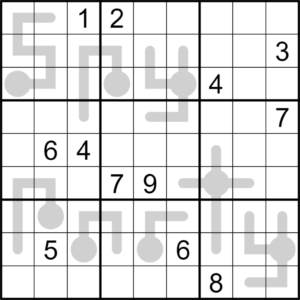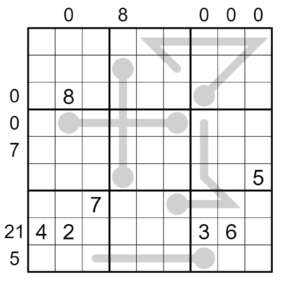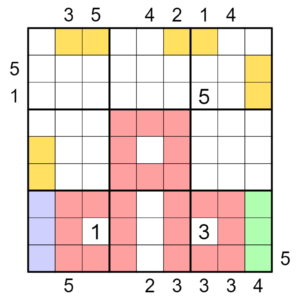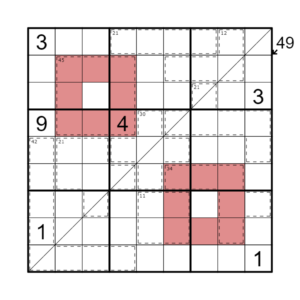Normal Sudoku Rules apply for all puzzles!
The grid must be completely filled with the numbers 1-9. Digits may not repeat within a box, row, or column. If you are new to Sudoku, I recommend looking at videos that explain some of the logic during a solve. If you’re new to any Variants, you can probably find puzzles or videos of most of them.
Tips for Spy (unknown Queen) Sudoku: Use lots of highlighting (I myself prefer highlighting where the Spy can be, but maybe you’d find the opposite more useful). When you can limit the potential positions of the Spy within a box, find cells that see all of them, as those cells cannot be the Spy, or it would eliminate all possible positions within that first box. If you have narrowed a Spy down to just two places in a row or a column, follow the diagonals for both and see if the diagonals themselves intersect, or look at where the diagonals intersect in the row/column of the other potential position. Similar to before, these intersections can’t also be Spies, or it would remove the possibility from both potential positions.
SpyParty Variant Sudoku #1, Thermometers, (w/hidden Spy)

Solvable link: https://f-puzzles.com/?id=yxzynn6y
Normal Sudoku rules apply.
Exactly one unknown digit is the Spy, and will never see itself on the diagonal. You will have to identify it to finish.
Thermometers are given. Numbers along the thermometers MUST increase from the bulb end (circle) to the tip.
An example: A thermometer that’s 8 cells long, the bulb must be either 1 or 2, the next cell must be either 2 or 3, the next cell must be either 3 or 4, etc.
Some tips to consider: Listing all the possibilities for each cell on longer thermometers can be useful. Anytime you remove a digit as a possibility from a thermometer cell, consider the effects on cells above or below it on the thermo. If a 9 must be on a thermometer, it can only be on the tip end (since there are no digits higher than it). Likewise if a 1 must be on a thermometer, it can only be on the bulb end.
SpyParty Variant Sudoku #2, Pub Food (Thermo+Sandwich), (w/hidden Spy)

Solvable link: https://f-puzzles.com/?id=y3ffhsz8 – I think this software occasionally has bugs with the error highlighting on Thermo/Sandwich puzzles. Disable it in settings or use it with caution.
Normal Sudoku rules apply.
Exactly one unknown digit is the Spy, and will never see itself on the diagonal. You will have to identify it to finish.
Thermometers are given. Numbers along the thermometers MUST increase from the bulb end (circle) to the tip.
Numbers outside the grid are Sandwich clues. They give the sum of the digits “sandwiched” between the locations of the 1 and 9 in that column (excluding 1&9 themselves from the total).
Example: A 0 clue means that the 1&9 are directly touching each other somewhere in that row or column (as the digits between them sum to 0). A 4 clue means the digits 1&9 are only one cell apart, and are separated from each other by a 4 (as you cannot sum to 4 in two digits without using a 1, since a row/column can’t have two 2s). Yes, this means you will have to do some basic additions.
Sandwich hints: All of the digits 1-9 sum to 45, so if you subtract the digits 1&9, you are left with 35 as the maximum sandwich clue (forcing them on the farthest possible outside points). A common tactic is to liberally use highlighting to determine which cells can be 1s&9s, and which cells may never be. For example, if you have one known 1/9 on the edge of a row, and a large sandwich clue in that row, you can do math to determine the minimum number of cells that clue needs (using maximum digits) and highlight that many as unable to contain 1s/9s, which might help some of your column clues. Occasionally in Sandwich Sudoku, you can determine the positions of all 1s and 9s before you even enter any digits into the grid.
SpyParty Variant Sudoku #3, Aquarium, (w/hidden Spy)

Solvable link: https://f-puzzles.com/?id=yxkbcv4q (DISABLE ERROR HIGHLIGHTING)
If you use f-puzzles software, disable error checking. I had to tell it the clues outside the grid were Sandwich clues in order to place clues outside the grid at all.
But this is where the fun puzzles start. Don’t tell me I said that.
Normal Sudoku Rules Apply
Exactly one unknown digit is the Spy, and will never see itself on the diagonal. You will have to identify it to finish.
Red zones (3x CCs) are strings of ascending/descending numbers. Think of them as unmarked 8-cell thermometers (you do not know the bulb, the end, direction, or which number is not included). Note: they do not need to be sequential, and often may not be, since one digit will be missing in each one.
Yellow zones must be filled with 1s, 2s, 3s, or the unknown Spy’s digit.
Clues outside the grid are “Shark” Sudoku! They tell you the number of squares a “shark” travels from that direction, before it finds a slow enough meal (a number equal to or less than the number of squares travelled so far [from that direction]). Example: a 3 clue outside the grid tells you the first digit must be higher than a one (or the clue would be 1), the second digit must be higher than a two (or the clue would be 2), and the third digit must be one, two, or three. The clue tells no information about the rest of the digits in the row/column past its number. If you want to get a grasp on this before trying it, I have a 6×6 shark-only grid (the digits 1-6 must fill every row/column/box exactly once): https://f-puzzles.com/?id=y6fkbbw9 (remember, disable error highlighting)
I made this up, so you won’t find help with this type online.
(The Blue/Green areas are added for aesthetics).
Yellow zones (statues): since some of them contain non 1s/2s/3s, these are something you gradually work on for most of the puzzle.
SpyParty Variant Sudoku #4, Twins, (w/hidden Spy)

Solvable link: https://f-puzzles.com/?id=yyrvtbx5
Now, on the surface, it looks like there’s a lot going on here, but all the information is basically in front of you all the time, so it’s not really harder to keep track of.
Normal Sudoku rules apply.
Exactly one unknown digit is the Spy, and will never see itself on the diagonal. You will have to identify it to finish.
Killer Cages are marked with a dotted line, and a number in the top right corner. The number is the sum of all digits within the cage. Numbers will never repeat within a cage, even across box boundaries (if you’re new to Variant Sudoku, this rule can vary from puzzle to puzzle, sometimes repeats are allowed. Not here though.).
Along the marked diagonal line, digits will never repeat. (at the end, it will contain all digits 1-9)
(DIFFERENT FROM BEFORE,) The marked red areas are direct Clones of each other (2x CCs). They are directly translated, and not rotated at all. Any logic you can apply to reduce options for one cell applies to it’s clone cell too. Again, these are NOT strings of increasing/decreasing numbers like the previous puzzle.
And there’s one secret ingredient here which makes this puzzle neat. The Spy has already done the “Poison a Drink” mission…this means the Spy appears once in every Killer Cage. That’s a potent clue, trace the Spy’s steps, and track the Spy down.
The 49 clue outside the grid points along a 8-cell diagonal. It gives the sum of all the cells it’s pointing at, but this time digits can repeat if needed. This is known as a Little Killer clue. I’m going to be honest with you, you should ignore this until the very end of the puzzle if you’re doing the “Harder” version, or I think you can ignore it the whole time if you’re doing the “Easier” version. Since digits can repeat, this clue gives very little information.
Okay, there’s a lot to unpack there. Where to start?
Killer Cages: Kinda just mathy. Some totals are immediately useful, and block certain digits from being within them, others won’t really be used until later. Again, the digits 1-9 sum to 45, so that 45 cage must contain all digits, exactly once since no repeats. That 8-cell 42 cage is only missing one digit. So what number will never appear in that cage?
Diagonal Sudoku: With only one diagonal, it only matters in three boxes, so just try and keep it in mind when you’re looking at possible positions for digits within those boxes. Or when you place a digit on the diagonal, check the other two boxes, and note where that digit got excluded from. Not terribly much to this.
Clone Sudoku: Seems straightforward? But you will have to use it a lot. Sooner than normal (though not necessarily right away), you might want to consider these spaces for listing out all possibilities, and compare them between clone areas. To be clear, only the red squares are clones of each other, the middle squares can’t be… Look at the starter hint if you don’t get Clone Sudoku at all.
That’s it for this year I think, thanks for trying them out!